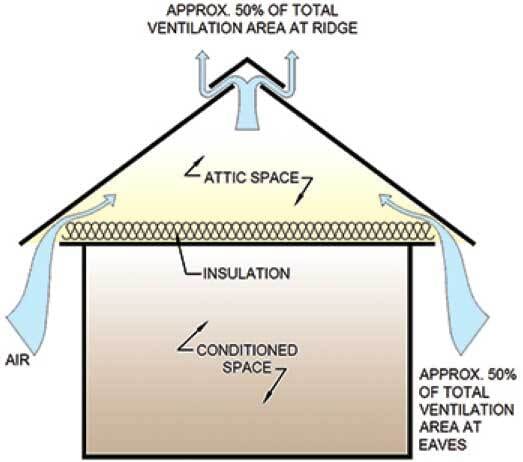AIR VENT FEATURE:
Photo credit: sturti/E+ via Getty Images
Addressing attic ventilation for every roofing project makes a difference by establishing a culture that spreads throughout the company and, in time, breeds more success.
An Attic Ventilation-Focused Culture Pushes Roofing Companies to be Better
The roofing company, the homeowner and the industry all benefit by ‘doing it right’
By Paul Scelsi
The vents intended to move air through an attic are, frankly, a tiny part of a roofing project and a fraction of the overall cost of a roofing project. Still, Aaron Santas, CEO of RoofCoach, says an attic ventilation-focused culture inside a roofing company helps create the mindset of doing the entire roofing project right every time.
In our podcast interview, he shared his first-hand experiences transitioning to this culture and the many benefits it produced.


“We’re really talking about focusing on correcting all aspects of the roof, not just the leak-sensitive parts,” Santas said. “One of the most overlooked aspects of a roofing project is attic ventilation because it can be a little mysterious to some contractors; and some contractors might think, ‘the attic venting isn’t keeping the roof from leaking,’ so their attention may not be focused on it.
“Also, attic ventilation can seem challenging to some contractors who attempt to fix it,” Santas continued. “Despite all of that, there are massive benefits to adopting an attic ventilation-focused culture and making it a crucial part of every roofing project you do.”
A proper balance of intake and exhaust vents allows consistent airflow through the attic, which can help fight heat and moisture buildup and ice dams. That, in turn, can help with the longevity of the roof, energy bills, indoor comfort level, etc. While those benefits do seem substantial, there are roofing contractors that may not give the attic ventilation the attention it deserves because, in the large scope of a roofing project, the vents are a small part.
Rivets on the Airplane
“The rivets that make up an airplane are a small part, too, but if the rivets are not all correct, I don’t know that I want to fly on that airplane,” Santas offered in a compelling analogy. “It really just boils down to it’s the right thing to do; I hear a lot of roofers say they do a really good job and that they do good work, but they leave out things like the attic ventilation.
“I think it’s an unconscious omission by some contractors. But what I try to explain to them is attic ventilation is like the heart and lungs of the home,” Santas continued. “Its job is to circulate air and help maintain temperature and help control moisture.
“Keep in mind shingle manufacturers have disclaimers in their warranties [warning about proper ventilation]. If you ask any homeowner whether or not they want the full terms of their shingle warranty, they’re going to say '[yes];' attic ventilation is part of that warranty and that, alone, should be reason enough to give the attic ventilation the attention it deserves.”

Addressing attic ventilation one roof at a time on every roofing project can make a difference. It can establish a culture that spreads throughout the company and, in time, will see even more success. Santas knows this first-hand.
“When I got into the roofing contracting side of the business, I was coming from the supply side [and] had a pretty good knowledge of the various components of a roofing project, warranties, and how everything was supposed to work,” he said. “I came into a roofing business that wasn’t following a lot of those rules and how all the pieces connect, so when I started talking about attic ventilation, doing attic inspections, and fixing ventilation … for deficient homes, I got a lot of push back.
“I persevered through that, and within a year, maybe a year and a half, the attitude inside our company changed to ‘we won’t do it any other way,’” he continued. “Our crews and our installers would start [calling] out the competition for [failing to] ventilate the right way; our whole culture and standards changed.”
“attic ventilation is like the heart and lungs of the home. Its job is to circulate air and help maintain temperature and help control moisture.”
— Aaron Santas, CEO, RoofCoach
Elevating Company Standards
Santas continued: “And the result … is you start fixing everything, and you start doing everything correctly and holding each other to higher standards throughout the company; you start attracting different types of employees, not to mention you’re doing the job right,” he said.
“And if you have an effective sales process, you can communicate all of this to homeowners, and you sell more work, and you can obtain more projects,” Santas added. “This culture we’re talking about touches every aspect of the business in a positive way.”
Santas says it can impact the industry at large over time.
“At our roofing company, we set the trend in our market for getting into the attic, designing balanced intake and exhaust attic ventilation systems, and doing things right,” he explained. “Within a year or two, other roofing companies were doing it too because they got tired of losing projects to us because we were doing it right.”
Santas noted that customers would ask competitors why they weren’t checking the attic.
“Now the roofing contractors I coach and train are sharing similar stories, telling me they see their competition starting to improve their game,” he said. “The bottom line is attic ventilation is not like a luxury item; it’s needed. It’s what’s supposed to be done.
“You ask any homeowner if they want to spend more money on their energy bills than they have to, they’re all going to tell you, ‘no,’” he said. “So if we can help them with their energy bills, even a little bit, it’s a benefit.”
Roofing companies with a "do it right or don’t do it at all" mindset provide finished roofs to homeowners who enjoy the confidence their roof will perform and last the way it is intended to.
“Every homeowner thinks whenever they buy a roof from whomever they buy it from, it’s never going to have a problem, and it’s going to work perfectly,” Santas said, asking rhetorically, “If that were the case, why would we have repairs? Why would we have premature failures?”
Doing it Right is Profitable
“I can’t speak enough about committing to proper attic ventilation and making that a staple; I preach this to anyone I work with,” Santas said. “If you really learn how to design and install attic ventilation properly, it will force you to be excellent at a few other things.
“And when you become different and better than your competition, [No. 1] you’re doing the right thing, and [No. 2] you also have something tangible to sell of value to the homeowner. You can gain more projects and actually do it for a higher dollar amount — because you can get a homeowner to pay for high quality if you can help them understand why; it’s a win all the way around.”
"Each roof is different and has unique aspects to it. I like to point those out when I can. Training doesn’t have to be a formal event or seminar. It can be learning on the job. That’s how I view every roofing project every day. I deeply desire to share knowledge and help others succeed with that knowledge.”
— Robby Wilkerson
Paul Scelsi is the marketing communications manager at Air Vent and leader of its Attic Ventilation: Ask the Expert seminars at airvent.com. He hosts the podcast “Airing it out with Air Vent” and chairs the Asphalt Roofing Manufacturers Association’s Ventilation Task Force. Scelsi is the author of “Grab and Hold Their Attention: Creating and Delivering Presentations that Move Your Audience to Action.”
